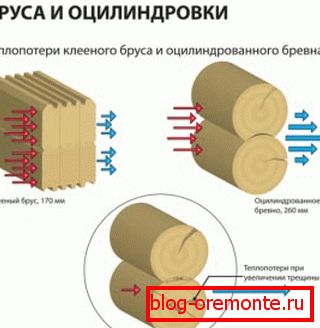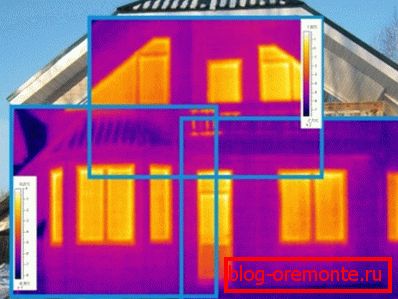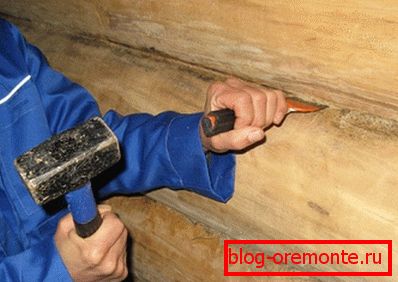How to insulate a house from a bar, having achieved maximum
Despite the fact that the tree is positioned as a material with low thermal conductivity, houses from a bar still need additional insulation.
Before insulating a house from a timber from the inside, it is necessary to determine which structural components of the building lead to significant heat loss.

There are a number of reasons for carrying out works on warming lumber walls, ceilings and floors:
- Substandard materials that were used in the construction of the house;
- Natural shrinkage and cracks in the walls of the log house;
- Low or incorrectly hydro-insulated foundation of the building;
- "Advanced age" at home;
- Adverse climatic zone with high humidity and significant temperature differences;
- The desire to reduce the cost of heating the house in the winter.
Let us dwell on the main stages of weatherization, which can be done with our own hands, even without significant experience in carrying out repair and construction works.
Causes of heat loss in the house of wood

Consider as a percentage what constructions of buildings need high-priority and high-quality insulation, as well as learn the advice of experts how to insulate a house from a bar correctly and with the lowest material costs:
- The walls of a wooden house, which undergone deformation during shrinkage, are often covered with a network of cracks. And in the joints may form a gap. Through the walls the house loses about 33 percent of the heat;

- Floors equipped with high-quality ventilation and properly waterproofed will help reduce energy consumption for heating by up to 35 percent;
- The roof of the building, equipped with a layer of mineral wool or polystyrene foam, will reduce energy costs by 20 percent.
Important. Be sure to take into account that polystyrene foam belongs to the class of materials of high flammability and during installation must be treated with flame retardant impregnation, preventing fire.
- Instructions for energy saving in wooden houses recommends that special attention be paid to the quality fitting of window and door openings. It is necessary to eliminate all gaps and gaps with the help of mounting foam. Also to eliminate defects in old houses will help insulating film and tubular rubberized insulation;

- In areas with high humidity in the early stages of construction, it is important to properly waterproof and insulate the foundation of the building.
Note! The house, protected from the inside and outside, resembles a kind of thermos and always provides coolness in summer and comfort in winter.
Sometimes, for several reasons, it is not possible to carry out external insulation of the building, although this option is preferable. Consider how to properly insulate a house from a timber inside, in order to achieve the lowest possible heating costs.
The choice of insulation

When choosing a material, it is important to pay attention not only to the cost, but also to the following characteristics, which a quality insulation for wooden buildings must necessarily have:
- The material must be non-flammable. It is recommended to use basalt fiber-based mineral wool;
- The manual also recommends the use of glass wool slabs for the interior decoration of residential premises, which has a low ignition rate and only melt when ignited, preventing fire from occurring.

Important. How to insulate lumber house from the inside, respecting environmental safety? Polyfoam and polystyrene foam for interior use is not recommended. In addition to being a flammable material, it also emits volatile chemicals that are unsafe for health during operation. Therefore, most often foam and polystyrene foam is used as external insulation for siding.
Modern technologies offer more expensive options for internal warming of wooden houses from a bar - insulation based on foamed rubber or sprayed insulation, but the price of such materials is quite high.
The order of the internal insulation works

Adhering to a certain order of work on insulation it is quite possible to carry out the internal insulation of a wooden house and with your own hands.
Preparatory work

Initially, it is necessary to conduct an audit of the walls, ceiling and floor of the building. Upon detection of cracks, thinning of the insulation layer or lack of a layer of old insulation material, it is important to eliminate these disadvantages before beginning the finish.
Special attention is given to the instruction on the insulation of wooden houses to be paid to the construction joints, corners and joints of bars. Cracks, chips and other defects that occur during house shrinkage are treated with a disinfectant primer for deep penetration wood and carefully putty. For the repair, you can use modern polymeric compositions based on organic resins, and for deep cracks you can use regular mounting foam.
Vapor barrier

In order for the moisture accumulating in the room not to settle on the walls of the house, it is necessary to install a layer of vapor barrier film. This layer will protect the wood from mold and rot.
Water condensate occurs as a result of vital activity and temperature difference in a residential area.
Council The installation of the internal vapor barrier is especially important to install before warming the bath of the beam. After all, it is in this room at home that the highest humidity and sudden temperature changes.
Installation of insulation

Depending on the size of the room, you can choose either large roll materials, or, conversely, on insulation made in the form of plates. It all depends on the geometry and floor space.
To prevent a large amount of waste area, which is supposed to warm, you must calculate in advance and select the most convenient insulating material.

Council It is convenient to fix the insulation to the walls with thin wooden slats fixed on the walls and the ceiling in the form of a grid with a step corresponding to the size of the insulating material. It is also important, especially when performing installation with your own hands, to follow the density of laying insulation. It is undesirable to allow gaps and gaps, as in these places there will be "cold bridges" and the coefficient of heat loss will be much higher.
Many modern interior insulation materials already have an additional outer layer of vapor barrier film that protects the material from the negative effects of moisture. If there is no such vapor barrier, then it is additionally mounted, installing over insulation.
Finishing

As the final cladding, you can choose a variety of materials.
It all depends on the planned design of a room:
- Decorative plaster;
- Plasterboard;
- Finishing of a bar plastic or wooden "lining".
Council Gypsum plasterboards are a great option for insulating a log house from the inside. After all, drywall itself is an additional and high-quality insulation.
Conclusion
Competent insulation from the inside helps reduce heat loss by 80 percent. The video presented in this article will help to carry out the whole complex of finishing works independently, significantly reducing the cost of repairs.